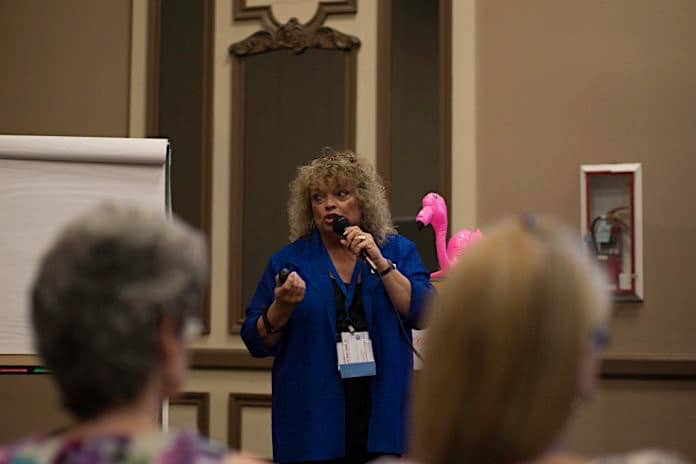Susan Hamre, a speech language pathologist at the Giant Steps autism organization near Chicago, on Tuesday provided STN EXPO attendees with practical steps to ensure students with autism have a safe and positive experience during their school bus ride.
Hamre has treated this specific population for decades and has her own private practice in New Mexico aside from her work with Giant Steps. There she offers training to educators, student transporters and first responders on how to communicate with students who have autism, including those who are nonverbal or minimally verbal.
During her presentation “Creating an Autism-Friendly Transportation Experience,” Hamre shared some tricks of the trade designed specifically for student transportation professionals, including the bus drivers who are usually the child’s first point of contact. When she asked the 60-plus attendees whether they oversee or operate special-education school buses, nearly all of them raised their hands.
First, Hamre explained that autism spectrum disorder is a neurobiological disorder that essentially means the child’s brain is “put together differently,” which means they interact with people differently than typically developing students. About 30 to 50 percent of children with autism have seizure disorders and/or cognitive delays. Many also have sensory challenges, repetitive behaviors and restricted interests, and may be minimally verbal or nonverbal.
“Some of these kids experience extreme distress with any change in schedules or transitions, which can be really scary for them. So imagine what happens when you change your route or have a sub driver,” she noted. “To prevent a major meltdown, you can use communication cards or social stories to tell them about the change in direction before it happens.”
Hamre offered the following tips for communicating with autistic students who are verbally limited:
- Utilize visual supports including cue cards, white boards and timers.
- Be short and concise with any verbal directions.
- Provide a model for good choices.
- Be patient with students who have processing delays, allowing five “slow” seconds.
- Use an effective communication system such as the Picture Exchange Communication System (PECS) or voice output device such as an AAC.
- Help them express frustration appropriately and problem-solve the situation.
She emphasized that bus drivers and monitors also need to develop problem-solving skills for this specific population. Then she provided a scenario involving an autistic boy who would bang his head on the window during much of the afternoon bus trip. When that happened, bus staff would place a towel or pillow by his window to prevent injury.
But what was odd, Hamre explained, was that the boy would suddenly stop doing it when they turned a corner and headed in a different direction. When she asked attendees why this might be, several answered and they were correct — the sun was in his eyes.
These types of sensory challenges are quite common, she said, and may include noise, light and tactile sensitivities as well as negative reactions to excess information.
“Your job is to make these kids as comfortable as you can while transporting them to and from school,” Hamre added.
To that end, she provided these additional recommendations for special-education student transporters:
- Be familiar with autism spectrum disorder.
- Ask questions when you need to like “How can we help?”
- Have communication cards on the bus.
- Ask the family or educator about the child’s communication system.
- Ask them for a “cheat sheet” of what works with that student.
- Know where the student’s “brain muffs” are kept, which muffle sounds.
- Resist responding negatively to social awkwardness or inappropriate behavior.
- Assure the child you are here to help him be safe on the bus and have a good trip.
- Remain calm. Be aware of voice volume and body language.
- Use basic, concrete language; do not use sarcasm.
- Employ the phrase, “The rule is…” rather than telling them what not to do.
- Celebrate and congratulate their strengths.
- Understand hitting, biting, spitting, kicking, etc. may occur if the child becomes unregulated while attempting to keep yourself and others safe.
- Understand and allow the child to carry special items on the school bus or van.
“Older kids with autism say they remembering feeling that they didn’t want people to give up on them. I learn more from talking with people who have autism than from reading articles and books,” continued Hamre. “They appreciate parents and teachers who showed they believed in them. You want to create mutual respect: ‘We’re in this together and we’re going to get you to school safely.’”
She told STN that in recent years, the demand for this type of training has grown exponentially along with the surge in the number of students diagnosed with autism. At Giant Steps, Hamre said dozens of school buses drive up from 60 different school systems daily, and her staff as well as her parents can tell which employees have received training on transporting special needs students and which haven’t.
“I’ve had several people say this training is helpful for all kinds of kids, not just children with autism. If you learn to handle the toughest of the tough, the easier ones come kind of naturally.”
The same holds true for Hamre’s unique training approach presented earlier today, titled “Revisit ‘Grandma’s Law’ Via Behavior Modification.”
“We all had Grandmas who adored us no matter what shape or condition we were in. Our grandmas loved us and respected us, and they got us to do whatever they wanted. How did they do that? If we look back, grandmas are pretty powerful,” Hamre continued. “I created this training to focus more on how you want your students to be, which includes how you treat them … This is not just for kids with special needs but for all kids — in fact, all people.”














